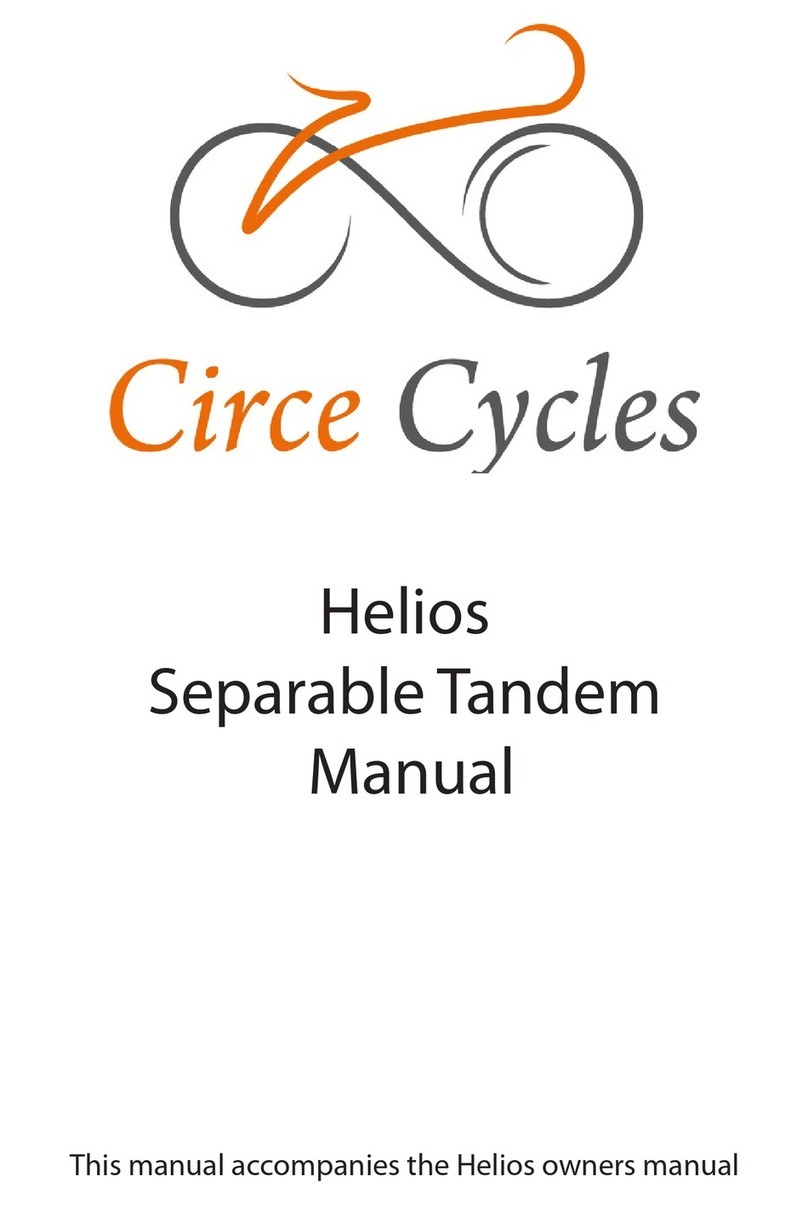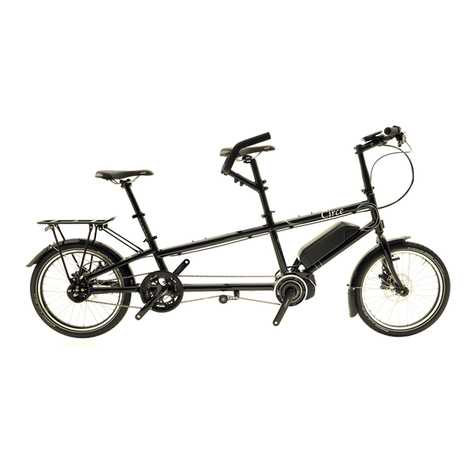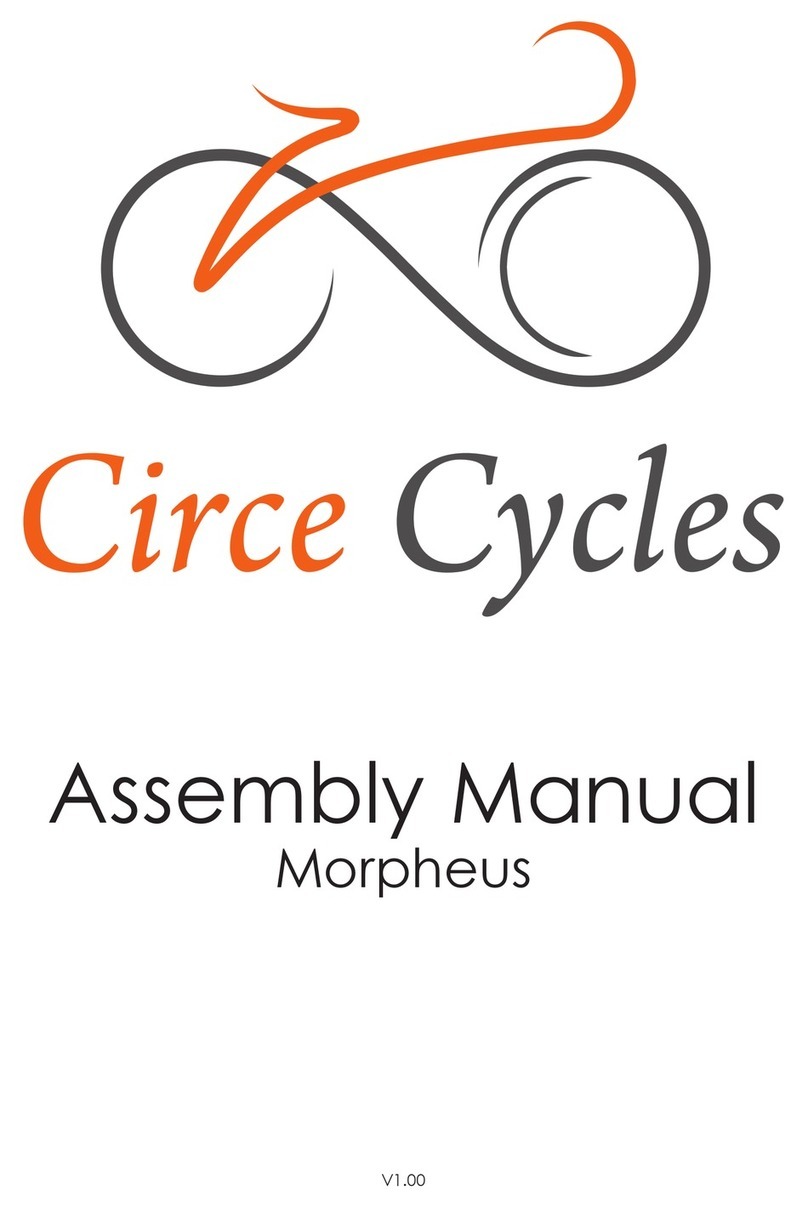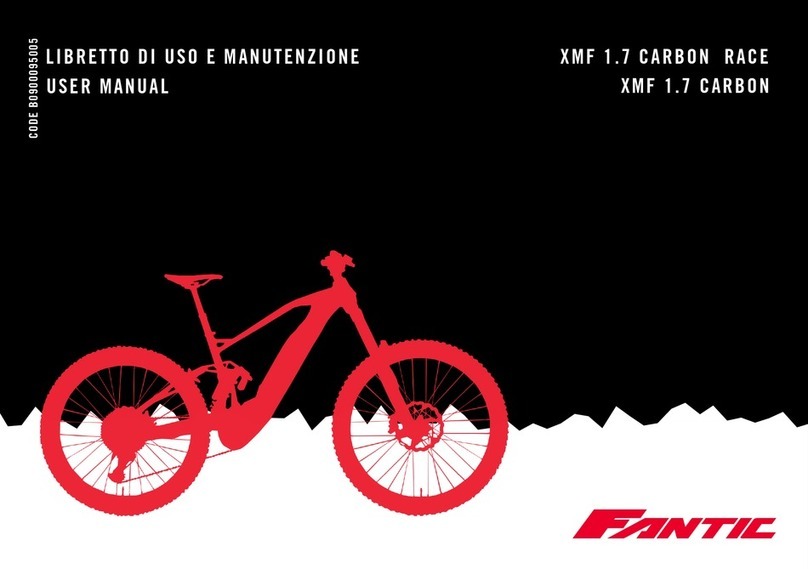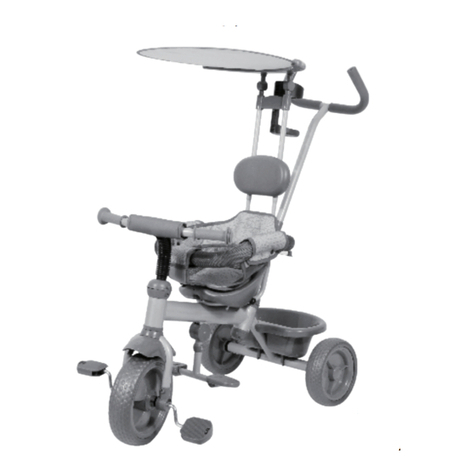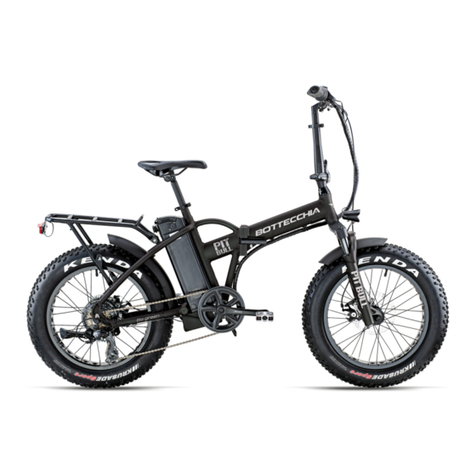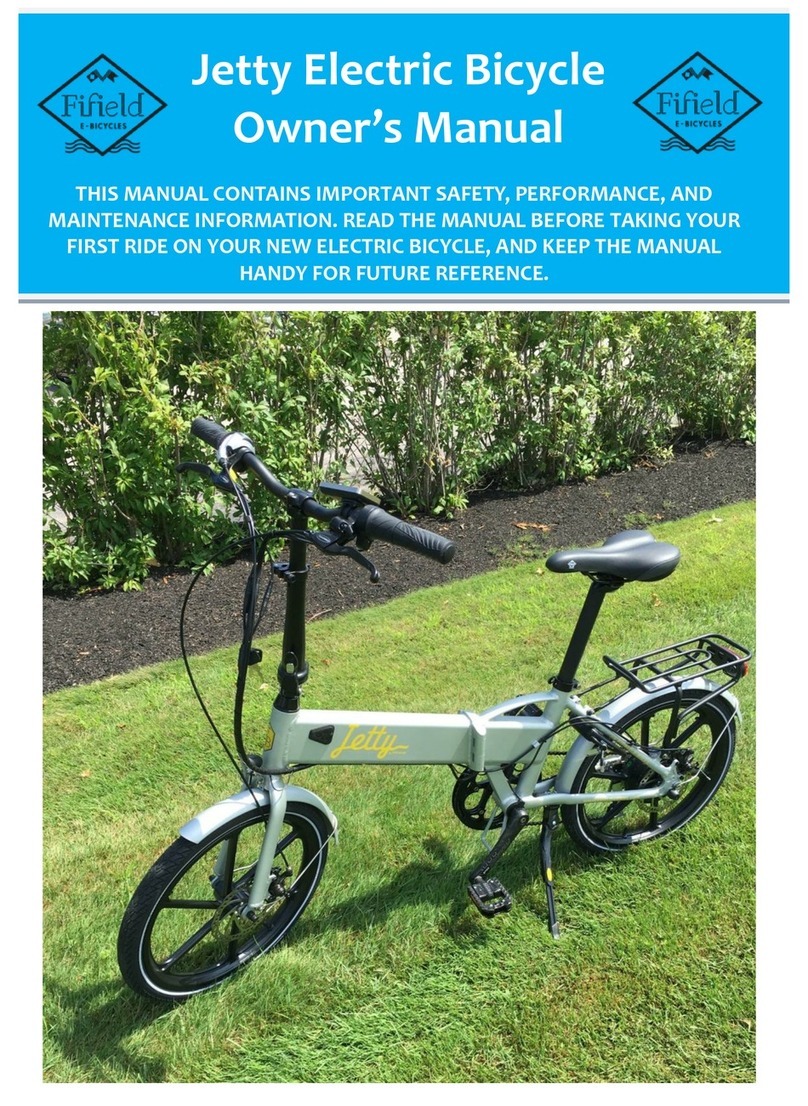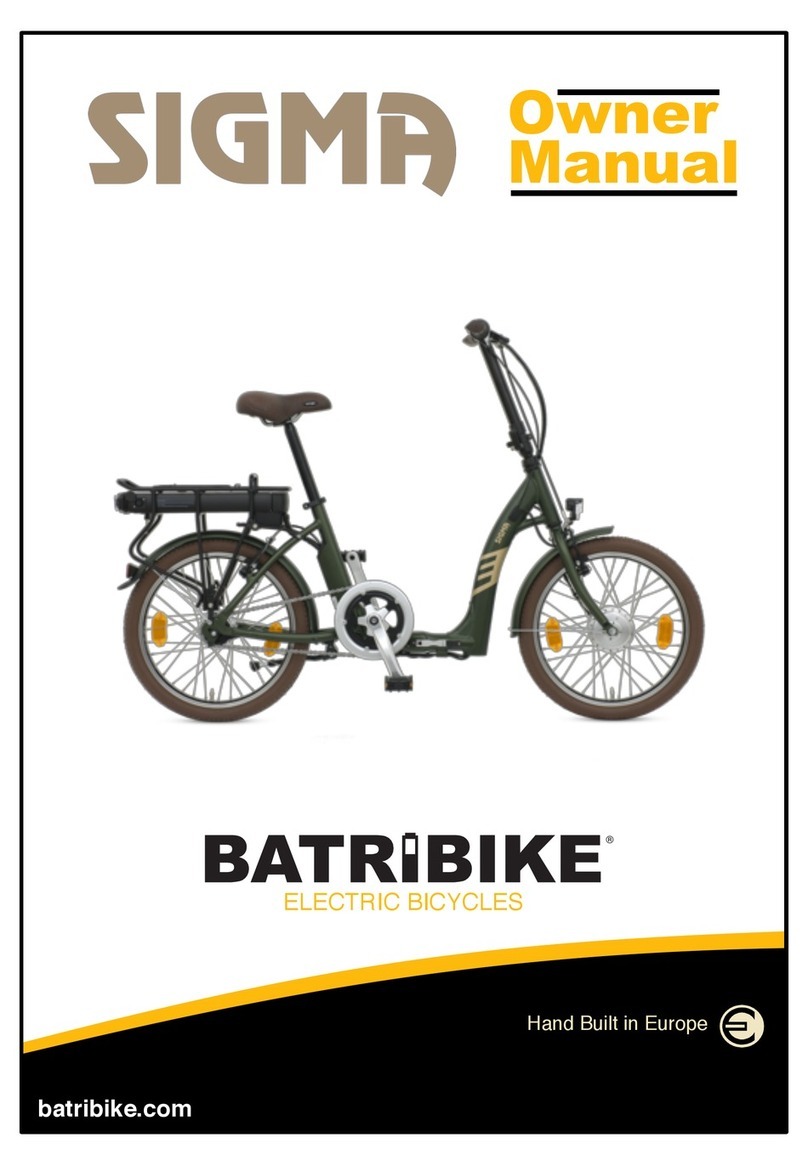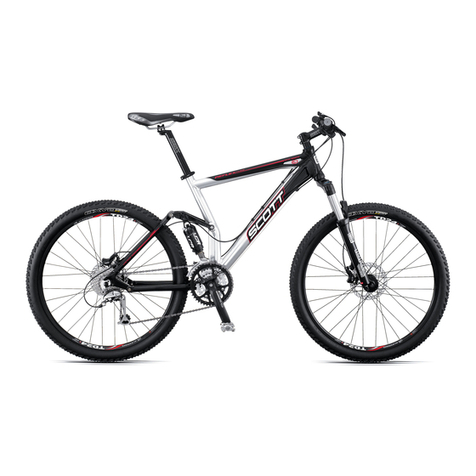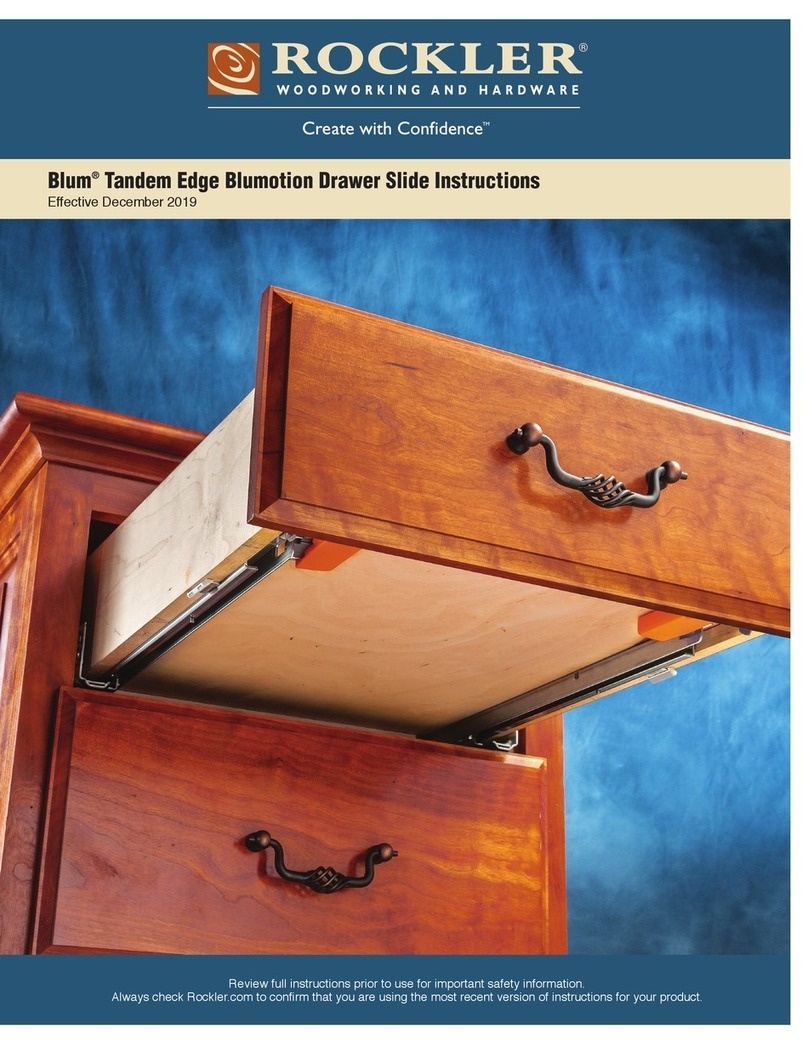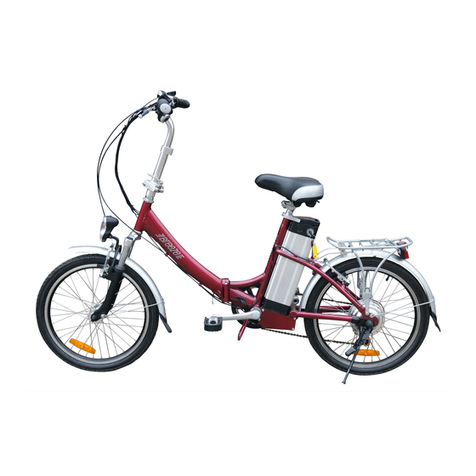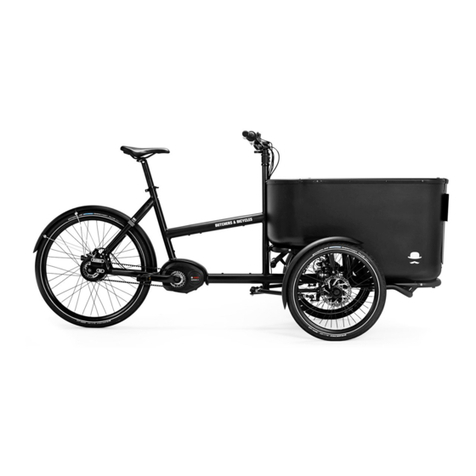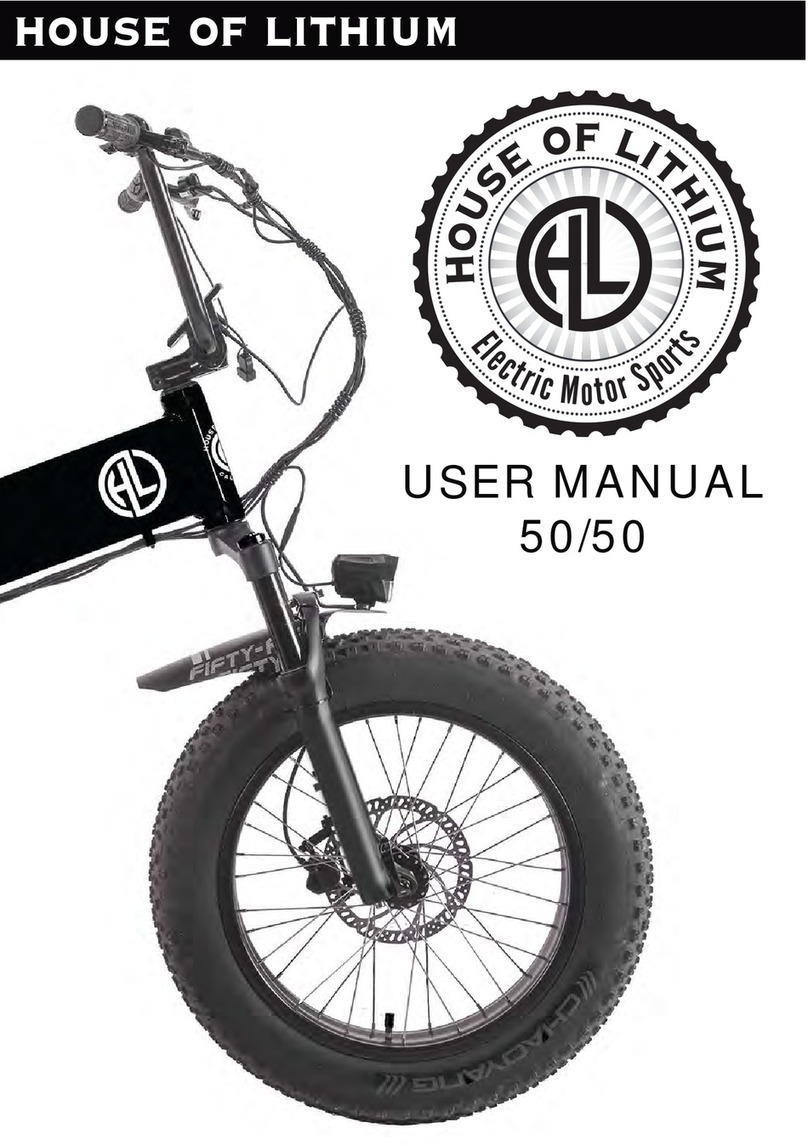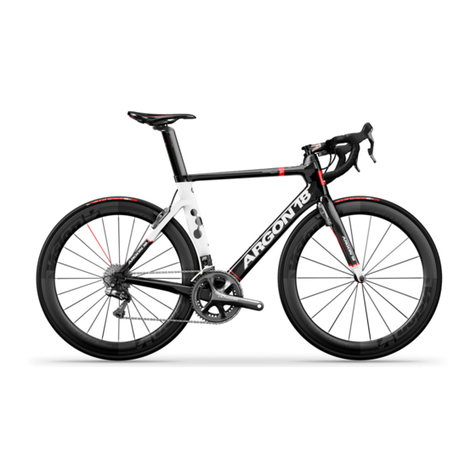Circe Cycles Morpheus User manual

Morpheus Owners Manual
covers all models
Duo
Brut
Omnis
Omnis Plus
Aurora

Introduction
Congratulations on becoming a new Circe Morpheus owner. The Morpheus is an innovative, functional, yet fun product that
works brilliantly at many levels. We are condent that it will give you many years of good and enjoyable service.
This manual is written to enable you to get the best from your bike. It includes sections on riding, maintenance and safety and
we have included some tips learnt from many years of riding and maintaining tandems. The latest version of the manual is
always available as a downloadable PDF document on our website - please make sure you read it thoroughly.
Finally, we get great pleasure everytime we ride our tandem, we hope that you will join us in getting many years of enjoyment
from this wonderful bike.
Contents
1.0 Introduction.............................................................................................................................................................................................................1
1.1 Contents..................................................................................................................................................................................................1
1.2 Overview.................................................................................................................................................................................................2
2.0 Ridng your tandem..................................................................................................................................................................................................3
2.1 Basics......................................................................................................................................................................................................3
2.2 Safety while riding..................................................................................................................................................................................3
2.3 Riding at night.........................................................................................................................................................................................3
2.4 Wet weather riding..................................................................................................................................................................................4
2.5 Clothing...................................................................................................................................................................................................4
3.0 Fit.............................................................................................................................................................................................................................4
3.1 Weight distribution.................................................................................................................................................................................4
3.2 Saddle height..........................................................................................................................................................................................4
3.3 Saddle angle and position.......................................................................................................................................................................4
3.4 Forward extension and bar position........................................................................................................................................................4
4.0 Controls and riding technique..................................................................................................................................................................................4
4.1 Starting and stopping.............................................................................................................................................................................5
4.2 Brakes and braking technique.................................................................................................................................................................5
4.3 Gear usage...............................................................................................................................................................................................5
5.0 Weight distribution and weight limits......................................................................................................................................................................5
5.1 Carrying children.....................................................................................................................................................................................5
6.0 Touring.....................................................................................................................................................................................................................6
6.1 Load carrying..........................................................................................................................................................................................6
7.0 Accessories...............................................................................................................................................................................................................6
8.0 Maintenance............................................................................................................................................................................................................7
8.1 Maintenance schedule............................................................................................................................................................................7
8.2 Brakes.....................................................................................................................................................................................................7
8.3 Cables.....................................................................................................................................................................................................7
8.4 Drive train...............................................................................................................................................................................................7
8.5 Frame and fork........................................................................................................................................................................................7
8.6 Headset...................................................................................................................................................................................................7
8.7 Seatpost..................................................................................................................................................................................................7
8.8 Tyres........................................................................................................................................................................................................8
8.9 Wheels....................................................................................................................................................................................................8
8.10 Quick releases.......................................................................................................................................................................................8
8.11 Steering Linkage...................................................................................................................................................................................8
9.0 Warranty.........................................................................................................................................................................................................................................9
9.1Liability information....................................................................................................................................................................9
9.2 Legal requirements.....................................................................................................................................................................................9
9.3 Contact information......................................................................................................................................................................................................9
Page 1

Page 2
18.
2.
4.
Key
1. Brake and gear levers
2. Chain tensioner (adjustable)
3. Drive train
4. Fork
5. Frame
6. Handlebar stoker
7. Handlebar captain
8. Headset
9. Hubs
10. Spokes
11. Rim
12. Saddle and post captain
13. Seat stoker
14. Seatpost quick release
15. Spokes
16. Timing chain
17. Tyres
18. Adjustable boom
19. Front platform mount point
20. Lower rack and front stand
mounting point
21. Upper rack mounting point
1.
3.
5.
6. 8.
7.
11.
12.
13.
14.
16.
9.
9.
11.
10.
10.
19.
20.
21.

2.0 Riding your tandem
Like any activity, cycling involves risk of injury and damage. By choosing to ride a bicycle, you assume responsibility for that
risk and need to practise safe and responsible riding. The following are points, that if practised, may reduce that risk. It is not
intended to be a denitive treatise on the subject and there may be omissions. Consequently, even strict adherence to these
points in no way guarantees survival.
2.1 Basics
1. Even though our bikes are manufactured and assembled to the highest standard it is essential that a thorough check is
carried out by an accredited dealer prior to rst use.
2. Prior to riding your bike, it is essential to carry out a mechanical safety and maintenance check - please familiarise yourself
with our ‘Maintenance Schedule’.
3. It is strongly recommended to wear an approved cycle helmet
2.2 Safety While Cycling
1. You must be thoroughly familiar with the controls of your bike.
2. It is essential that you are familiar with, and observe, the local trac regulations.
3. Be aware of your speed and never exceed a speed at which you feel safe and have time to stop your bike in unforeseen
circumstances.
4. Don’t jump with your bike.
2.3 Riding at night
1. it is not recommended to ride a bicycle at night, but if you do, it is essential and, frequently a legal requirement, that ap-
proved lights be used front and back. These light should be both of sucient brightness to illuminate the road ahead and so
that other road users can clearly see you.
2. Always wear reective clothing. Reective vests or bands over the body and bands for the arms and legs are also very eec-
tive.
3. Make sure that your bike is well equipped with reectors.
2.4 Wet Weather Riding
1. Braking performance and stopping distances are very detrimentally aected in wet conditions compared to riding in the
dry. It is essential to make appropriate adjustments to your speed and to allow increased distance for stopping.
2. The use of mudguards can help to improve visibility both for you and for anyone following you.
3. It is important to wear appropriate clothing. Waterproofs obviously, but a peak on your helmet or cap can greatly enhance
forward vision.
2.5 Clothing
1. It is advisable to wear bright highly visible clothing that is not loose enough to to catch on the bicycle’s moving parts or be
snagged by objects at the side of the road.
2. Always wear reective clothing at night. Reective bands or vests over the body and bands for the arms and legs are also
very eective.
3. Always wear shoes that will stay on your feet and will grip the pedals. It is potentially dangerous to ride barefoot or in open
shoes like sandals.
4. Protective eye wear can help to see in bright sunshine and can prevent damage from impacts with insects and road debris.
3.0 Fit.
To ensure that riding your bike is the pleasurable experience it should be, it is essential that attention be paid to correct t.
Ideally this should be done in conjuntion with an accredited dealer, but the following points should be observed.
3.1 Weight distribution
It’s usual for the larger rider to be the‘Captain’ , this is because the back rider is responsible for stabilising the tandem when
starting and stopping, for steering, and for braking which particularly on long descents can be very demanding.
Page 3

3.2 Saddle height
This dimension is very important for bio-mechanical eciency and for protecting joints from injury. As a working rule, with
the pedal at the furthest position from saddle and the rider's heel on the pedal, the leg should be straight to very slightly bent.
This means that when the foot is in the correct position with the ball of the foot on the pedal axle, the knee will be slightly
bent at full extension. The degree of bend is personal, but it is important that, at full extension during the pedalling cycle, the
knee is neither overstretched nor too bent.
'!' Certainly for children we advise the use of adjustable crank shorteners, and anyone outside typical average leg lengths
should consider such shorteners or appropriate length cranks.
3.3 Saddle angle and position
Ideally the captain’s saddle should be adjusted fore/aft so that the centre of the knee joint is vertically above the pedal axle.
The saddle top should be approximately horizontal, but care should be taken with the angle of the saddle, particularly so that
the nose does not obstruct forward rotation of the pelvis. The stoker seat can be adjusted for/aft using the two frame
mounting points, and can be adjusted for incline using the bolt on the captain’s head tube. Leg extension can be further
adjusted by moving the front boom in and out.
3.4 Forward extension and bar adjustment
For comfortable riding, the amount of stretch of the back, torso and arms are crucial. An experienced rider should use the po-
sitions with which they are normally comfortable, but for rst time riders, a good starting position should not be too stretched
or bent over. With familiarisation this position can be gradually adjusted. The stoker seat oers a very comfortable seating
position with the handle bars under the seat which acn be pivoted for a comfortable hand postition.
4.0 Controls and Riding Technique
Traditionally the front rider is known as the 'Captain' and the rear rider, the 'Stoker'. On the Morpheus this is reversed the front
rider is the Stoker and the rear the Captain. The Captain steers, has control of the brakes and gears and is responsible for sta-
bilising the tandem when starting and stopping. The Stoker pedals and should otherwise relax and not attempt to steer! For
some applications, the Stoker may have an auxilliary drag brake.
4.1 Starting and Stopping
At start, the Captain will mount the tandem, keeping it stable so that the Stoker can sit on the front seat with feet on pedals
ready to go. The Captain will then sit, and, keeping the tandem upright with one leg, will, with the stoker, start pedalling. It is
important to start in a low gear and for both riders to give a good hard push to get the tandem underway!
To stop, the Captain should warn the Stoker and then, as on a single bike, put one leg down to stabilize the bike. The Stoker
usually remains seated with feet on the pedals, but must keep still so as not to unbalance the tandem. If the tandem is at rest
for a longer period, one or both riders should be prepared to place both feet on the ground.
4.2 Brakes and Braking Technique
The Circe is tted with excellent brakes that are able to stop the tandem quickly and safely. However, it is important to remem-
ber that a tandem is heavy and, consequently, with braking distances being greater than on a single, it is very important to be
aware of trac conditions and not rely on last minute, panic braking.
In use, both brakes should be used, but the front brake is the much more eective brake and does the majority of the stop-
ping. Consequently, a lot of heat can be generated in the front wheel braking surfaces and, if long descents in mountainous
areas are anticipated, some form of auxilliary braking should be considered. If the tandem is tted with disc brakes then rim
brakes can be added and vice versa if rim brakes are tted. This enables the dierent braking surfaces to be alternated and any
heat build up to be controlled better.
4.3 Gear Usage
Your Circe is tted with a good range of gears, each model having an appropriate gear range for its intended use. It is im-
portant to use the gears to nd a cadence (leg spin speed) that is comfortable for both riders and, by being aware of road
conditions, to use the gears to try and keep within this range. Although mutual comfort is the most important requirement, a
cadence of 80-100 is generally considered to give a good bio-mechanical balance, though, obviously this may vary depending
on a variety of physical factors, both personal and terrain. The stoker chainset is on a freewheel to allow independent
pedalling.
Page 4

5.0 Weight Distribution and weight limits
As previously stated, because the steering is at the rear it is better for the heavier rider to be the captain. If luggage is to be
carried it is advisable to try and maintain as even a weight balance as possible, possibly using the mid ship rack and panniers
to achieve this.
The Morpheus has a weight limit of 200kg.
5.1 Carrying Children
The Morpheus is particularly suited to carrying children, but great care must be taken to ensure their safety. It is essential
that they wear approved cycling helmets and that they are securely fastened into any child carrying seats. If the Morpheus
platform is used, it is essential that the dedicated ttings are correctly attached and the seat/s securely installed. The tandem
should then be safely supported either on its dedicated front stand or against something solid before the child is placed in the
seat. In this conguration, the Morpheus can take one adult and one or two small children.
6.0 Touring with Morpheus
Tandems make great machines for touring. Two riders of unequal strength can ride together and share the joys of cycle travel.
The Morpheus can be equipped with a full touring complement of panniers and bags and with suitable gearing is capable of
going anywhere. Remember, it is low gears that are essential for loaded touring; one can always freewheel downhill or with
the wind behind you, but you have to pedal up hills and against the wind.
If you are thinking of a full camping tour, we would advise three brakes - two discs and one rim. It is also important to ensure
that the luggage weight is well distributed, possibly using both middle and rear panniers.
6.1 Load Carrying
The Morpheus is a great load carrier, both for two people touring or shopping, but also as a single bike with its dedicated
platform. When loading the Morpheus, it is important that all bags and luggage are attached securely and that straps are tight
and not able to snag on anything. If used as a solo freight carrier it is vital the load be secured carefully.
7.0 Accessories
There are a number of recommended accessories for your Morpheus :-
1. Lights - even if you don’t plan on riding in the dark, there is always the chance of getting caught out late and it is essen-
tial, and in many countries the law, to have working lights.
2. A good pump, spare tube and puncture repair kit and took kit. With a tandem, because of the extra weights involved it is
essential to have a pump that can reach the necessary high pressures.
3. A good quality stand for parking and loading your tandem. The Helios dedicated stand will be perfect for stabilizing the
tandem when loading children or freight.
4. Mudguards.
5. Speedometer.
6. Carrying bags add to the versatility of any bike. The Helios comes with attachment points for racks and bags at the middle
and back of the bike. Best to discuss with your supplier what works best for your needs.
Page 5

Page 6
8.0 Maintenance
8.1 Service and Maintenance Schedule
Component Before every ride Monthly Annually Other
Brakes x
Cables x
Drive train x
Handlebars/stem x
Headset x
Frame/Fork x
Quick releases x
Tyres x
Wheels x
Steering linkage bolts x
8.2 Brakes
Depending on what model of bike you have, it will either have Disc brakes, V brakes or a combination of both. With V brakes
you should check that the brake pads have not worn below their minimum wear line are correctly aligned to the rim and not
touching the tyre. If the brake lever pulls all the way to the bar before engaging then you should refer to the cable adjustment
section. Or consult a professional mechanic. Disc brakes should also have their pads checked regularly, and if embarking on
a long ride it may be worth replacing the pads even before they reach their minimum wear line. The disc also needs regularly
checking for damage, alignment and thickness (the minimum thickness is normally specied by the disc brake manufacturer).
Note: Brakes on a tandem have to work doubly as hard as on a solo bike, so ensuring they are functioning eectively is critical!
8.3 Cables
Cables don’t normally need a lot of adjustment. When they are new, they will stretch slightly, and that stretch needs to be
adjusted out of the system. Check all cables regularly for signs of damage.
Brake Cables
To adjust the brake cables, loosen the locking nut on the barrel adjuster at the lever. Screw the barrel adjuster out a little and
check the brakes. When squeezing the lever, it shouldn’t come too close to touching the handlebar grips. When the lever is
released, the wheel should turn freely and not drag on the brakes.
Derailleur Cables
These are adjusted in the same way as brake cables. There is an adjuster on the rear derailleur, but none on the front. For the
front derailleur, it is only necessary to have the cable tensioned slightly when the chain is on the inside chain ring; ne tuning
can be done using the adjuster on the left-hand shifter.
8.4 Drive train
Check that the cranks are tight after the rst 50 miles of riding. These should be fastened rmly to the bottom brackets, with
no play. Even a small amount of movement will cause the joint between the spindle and the hole in the crank to wear, result-
ing eventually in damage to the chain set.
The rear derailleur idlers tend to collect oil and dirt. Clean them with a dry rag. If they squeak, they can be disassembled and
greased. When you lubricate your chain, put a drop of light oil on the moving pivots of the derailleur; they will last much
longer. The more you ride your bike, the more used you become to the sounds it makes. If you notice any change in the sound
your bike makes, check it carefully; it may be a sign of something needing attention.
8.5 Handlebars/stem
The Captain handlebar has two points of adjustment to give three degrees of adjustability see Picture 1.1

IIT IS CRITICAL THAT THE CLAMPS ARE TIGHTENED CORRECTLY TO STOP THE BARS MOVING BEFORE RIDING!
8.6 Headset
The headset is the bearing which allows the fork to rotate in the frame, it plays a major part in the handling of the bike and
should be checked regularly (as per table); that it’s both tight (not rocking front and back when front brake is applied and bike
rocked backward and forward), or, not turning smoothly. The Morpheus has two headset bearings, one for the captain handle
bar and the other for the fork, both must be tight for the bike to operate safely. If you are unsure about adjusting your head-
set, consult a qualied mechanic.
8.7 Frame/Fork
The frame of your Tandem is made from high grade aluminium tubing with a powder coat nish. Though Aluminium does not
rust like steel, it does still oxidise, so it is worth touching up scratches as they happen to keep the frame in top condition. It is
also worth checking the frame periodically for signs of cracking which can occur if the bike has a hard impact.
The forks are made from chro moly steel and are also powder coated, scratches should be touched up to prevent rusting. As
with the frame, the forks should be checked if the bike sustains a hard impact.
8.8 Quick release
Quick-releases are used in a number of places on your bike; it is important that they are tightened correctly. To locate a quick
release properly, adjust the quick-release by opening it, holding both ends and turning one clockwise until, when you close
the lever, you feel some resistance. At this point, try to close the lever fully. The adjustment is correct when you can fully close
the lever, but with some eort (the lever should leave its impression in the palm of your hand). If you can only close the lever
part way, open it, unscrew the adjusting nut slightly and try again. If it closes too easily, tighten it up a tiny bit and try again.
Picture 1.1
Open Closed
Page 7

8.9 Tyres
Quality tyres are vital for good traction and control while accelerating, turning and braking. Each brand of tyre has its own
individual mix of puncture protection, rolling resistance, pressure rating, and durability. Finding the one that suits your riding
style best is the challenge. Tyres should always be inated according to the range marked on the sidewall, never above the
maximum recommended, and they should be checked regularly. Worn tyres should be replaced. Lower pressure results in a
more comfortable ride, but at the expense of higher rolling resistance. Balloon tyres are now available that combine relatively
low rolling resistance, puncture protection, and a smooth ride; they are well worth considering. With two adults on the tan-
dem we recommend having the tyres inated to the upper limit of the marked pressure range. See tyre pressure table.
NOTE: IT IS IMPORTANT THAT BOTH TYRES ON YOUR TANDEM ARE INFLATED TO THE RECOMMENDED PRESSURE AS PER
THE TABLE.
Tyre Model Pressure range Recommended with two adults on
tandem
Schwalbe Big Apple 30-70PSI (2-5 bar) 70PSI (5 bar)
Schwalbe Marathon 45-70PSI (3-5 bar) 70 PSI (5 bar)
Schwalbe Marathon Supreme 50-80PSI (3.5-6 bar) 80 PSI (6 bar)
8.10 Wheels
The wheels on your tandem are made up of three components; the rim which holds the tyre on, and provides a braking
surface, the spokes which support the hub in the middle of the rim, and the hub around which the wheel rotates. All three
parts should be checked regularly (as per maintenance table), rims should be checked for wear and straightness, spokes that
they are all at correct tension and none are broken, hub for play in bearings and signs of damage to ange.
8.11 Steering Linkage
The steering linkage transfers the turning force from the handlebars to the forks, it is therefore critical that all the bolts which
hold the linkage in place are correctly tightened. A general check of the steering linkage for play should be done BEFORE EVE-
RY RIDE, as any play in the steering may lead to a loss of steering when riding the bike. Picture 1.2 shows correct torque values
for each bolt in the linkage. Correct adjustment of the steering rod itself is needed for the handle bars to be straight relative to
the front wheel and should be carried out with the front seat removed. Once the correct adjustment is achieved, the locknuts
should be tightened against the steering rod to prevent the rod eyes from coming loose.
Steering lever
16 Nm
Steering lever
Steering
rod eye
Fork mount lever
18 Nm
18 Nm Steering rod
Locknut
Picture 1.2
Page 8

Page 9
9.0 Warranty
Cyclecentric warrants, to the original owner of each new Circe tandem, that the frame is free of defective materials
and workmanship for two(2) years from original date of purchase. Component parts are limited to one (1) year from original
date of purchase. Warranty is conditionalupon the bike being operated under normal conditions and being properly
maintained. Warranty is oered to the original owner only, and is not transferable. This warranty does not apply to:
•damagethroughnormalwearandtear
•neglect(inadequatecareandmaintenance)
•damagefromcrashesorjumping
•overloadingthroughexcessweight
•incorrectassembly
•modicationstothebike(additionalorchangedcomponents)
•theft
•useasapowerdrivenvehicle
•failuretofollowinstructionsorwarningsintheowner’smanual
•Activitiesforwhichtheywerenotdesigned.
Bending of frames, forks, handlebars, seat posts or wheel rims can be a sign of misuse or abuse. Cyclecentric reserves the right
to make sole determination of whether any failure or damage claimed under warranty was caused by material or manufactur-
ing defect, and reserves the sole discretion to repair or replace any parts covered by this warranty. The owner shall be respon-
sible for all labour, shipping, and travel costs connected with the repair or replacement of warranted parts. Cyclecentric will, at
our sole discretion, normally consider compensation for reasonable labour, shipping, and travel costs associated with warranty
claims. Cyclecentric shall in no event be liable for incidental or consequential losses, damages or expenses in connection with
its bicycle products.
9.1 Liability waiver
Taking part in any sporting activity can result in injury or death. Cycling is no dierent in this regardIng many ways.
Nevertheless, the riders (that’s you) is expressly assuming the risk for any injury and/or property damage that may result from
using our product, as well as for any and all injuries and/or property damages caused by someone riding your bike. We have
no control over how the bike is used or maintained. It’s your bike; it is up to you to be responsible for yourself. You need to
ensure that the bike is safe each time before you ride it. You need to ensure that it is maintained to a proper standard. Read
and understand this manual; it has warnings and suggestions that will help you to use the bike safely. If you are in any doubt
about any of the advice or procedures in this manual, please contact your dealer or Cyclecentic. It is up to you to know and
obey trac laws of the country or state where you will be riding your bike. Pedal cycles are regarded in most countries as
vehicles when on the road and are subject to the same rules as motor vehicles. If you are not comfortable on the road, or have
little experience riding in trac, try practising riding on quieter streets, at least until you develop the necessary skills and road
awareness. Many bike shops can oer instruction on advanced riding techniques.
9.2 Legal requirements
Legal requirements vary from country to country and you should always comply with them.The important areas you need to
consider are lighting, and helmet use. Consult your local bike dealer for information about what is required in your area. Please
also remember that even if not required by law, some equipment (such as helmets and lights) can increase your personal
safety and should be carefully considered.
9.3 Contact information
Cyclecentric Ltd
37 High Street
Longdstanton
Cambridge
CB243BP
tel. +44 (0) 1954 782020
Other manuals for Morpheus
1
This manual suits for next models
9
Table of contents
Other Circe Cycles Bicycle manuals
